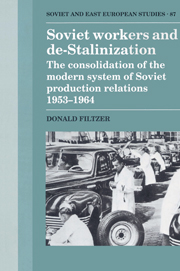 Soviet Workers and De-Stalinization
Soviet Workers and De-Stalinization Published online by Cambridge University Press: 29 January 2010
The primary problem which the Soviet elite faces in its attempts to administer the economy is its limited control over the production, appropriation, and disposition of both the absolute and relative surplus product. This manifests itself in a number of ways. First, the actual size and location of the surplus in pure physical form is to a large extent simply unknown. Enterprises falsify output figures or understate capacities. Part of output is literally lost in transit or warehousing. It is quite impossible to dispose of a product whose physical dimensions and whereabouts cannot be determined. Secondly, control is also undermined by the circumvention of planning directives and instructions by enterprise managers and their workers. Orders to produce a specified quantity of a particular good are frequently distorted, or even supplanted at enterprise level. The good in question is produced in the wrong amount or to the wrong specifications, or the enterprise manufactures something else altogether – either because this allows it more easily to fulfil its plan or because external circumstances (for example, the absence of the right kinds of supplies) leave it no other choice. Here, too, the centre simply has no idea of the fate of investment decisions or product orders, thus undermining attempts at coordination. Thirdly, disposition over the surplus product is constrained by the fact that the size of the actual surplus lies far below what the economy could potentially produce (or what the planners expect it to produce, which is not the same thing), essentially because of lost output.
To save this book to your Kindle, first ensure [email protected] is added to your Approved Personal Document E-mail List under your Personal Document Settings on the Manage Your Content and Devices page of your Amazon account. Then enter the ‘name’ part of your Kindle email address below. Find out more about saving to your Kindle.
Note you can select to save to either the @free.kindle.com or @kindle.com variations. ‘@free.kindle.com’ emails are free but can only be saved to your device when it is connected to wi-fi. ‘@kindle.com’ emails can be delivered even when you are not connected to wi-fi, but note that service fees apply.
Find out more about the Kindle Personal Document Service.
To save content items to your account, please confirm that you agree to abide by our usage policies. If this is the first time you use this feature, you will be asked to authorise Cambridge Core to connect with your account. Find out more about saving content to Dropbox.
To save content items to your account, please confirm that you agree to abide by our usage policies. If this is the first time you use this feature, you will be asked to authorise Cambridge Core to connect with your account. Find out more about saving content to Google Drive.